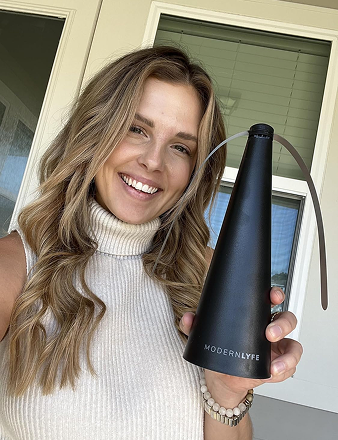Yes, door fans work. They create a powerful, invisible wall of air that flying insects can't get through. It's a simple and effective alternative to screen doors or chemical sprays, letting you enjoy fresh air without unwanted pests.
How Air Curtains Create a Bug-Free Zone
Picture a perfect day with your door open, letting a cool breeze flow through your home. The only problem? Flies, mosquitoes, and gnats. This is where a door fan shines.
These devices, often called air curtains, are much more than your average fan. They are engineered to create an invisible shield of air.

The science is simple. You mount the fan above your doorway, and it pushes a high-velocity stream of air downward. This powerful flow forms a continuous "curtain" that small insects find impossible to breach. Their wings can't generate enough power to fight the downward force.
The Invisible Barrier in Action
Think of it like trying to walk against a strong headwind—it's tough, and you eventually give up. For a mosquito or a housefly, that air curtain is an impassable barrier. It's an effective method that doesn't rely on chemicals or physical screens that get in the way.
Here’s why it works so well:
- Always on Guard: An air curtain is always active when the door is open. You never have to worry about it being left ajar.
- Chemical-Free Solution: It's a safe alternative to insect sprays, making it perfect for kitchens, restaurant patios, and any space where hygiene is key.
- Unobstructed Entry: People and pets can walk through freely without any physical obstacle, which is a game-changer for high-traffic areas.
This isn't just theory. Studies show that an airflow of just 7.25 meters per second is enough to block nearly all insects, achieving an efficacy rate as high as 99.9%.
The biggest advantage of an air curtain is its reliability. It's a consistent, active defense that pests can't outsmart, giving you instant peace of mind.
For simpler solutions on smaller areas like a patio table, check out our guide on using a fly repellent fan.
Finding the Right Door Fan for Your Space

Choosing the right door fan is about creating an effective pest-free zone. The right size and power make the difference between a real air barrier and just a light breeze. A fan that's too small or weak is a welcome mat for bugs.
First, grab a tape measure. The golden rule is that your air curtain must be at least as wide as the doorway. For best results, choose a model that extends a few inches past the frame on both sides. This overlap is crucial for creating a complete, gap-free curtain of air.
For wide entrances like double doors, installing two smaller fans side-by-side is often the best way to ensure total coverage.
Why Power Matters More Than You Think
Air velocity is the key. A gentle puff of air won't stop a determined fly. You need a fan that can push a powerful, consistent stream of air from the top of the doorway all the way to the floor. This is how door fans to keep bugs out create that invisible wall.
When comparing models, consider these real-world factors:
- Taller Doors Need More Power: For high doorways, you'll need a fan with a stronger motor to ensure the airstream stays effective all the way down.
- Know Your Pest: Gnats are easy. For larger insects like house flies and wasps, you need higher velocity to physically block them.
- Outdoor Conditions: Is your door exposed to wind? A constant breeze from outside will fight your air curtain, so you'll need a more powerful unit to compensate.
A Quick Guide to Choosing Your Fan
Here's a quick comparison of what to look for, whether you're protecting your home or a commercial space.
Key Features for Selecting Your Door Fan
| Feature | Residential Focus | Commercial Focus |
|---|---|---|
| Air Velocity | Strong enough for flies and gnats | High-powered for all insects, even with high foot traffic |
| Noise Level (dBA) | Low dBA rating is critical for a peaceful home environment | Noise is less of a concern; performance is paramount |
| Size & Fit | Must cover the door width; aesthetic appeal is a plus | Must extend beyond the frame; multiple units for wide doors |
| Durability | Built for intermittent use | Heavy-duty construction for constant, all-day operation |
| Energy Efficiency | Models with low-wattage motors to save on electricity bills | ENERGY STAR® certified to reduce operational costs |
| Certifications | Not always necessary, but a good indicator of quality | NSF and AMCA certifications are essential for performance |
Ultimately, whether for a patio door or a busy restaurant kitchen, the goal is an unbroken curtain of air.
Look for Proof of Performance
Don't just trust marketing claims. Independent certifications from organizations like the National Sanitation Foundation (NSF) and the Air Movement and Control Association (AMCA) are the real indicators of a fan's effectiveness. These seals mean the fan has passed rigorous, standardized testing.
One study showed that just three AMCA and NSF-certified air curtains slashed fly infiltration by over 99.9% in a warehouse. That’s the kind of reliable performance you should be looking for.
A certified fan is an investment in a proven solution. It gives you confidence that the unit will do its job day in and day out.
Finally, consider the details. For your home, a quiet fan with a low decibel (dBA) rating is a must. For a commercial space, durability and energy efficiency will save you money in the long run.
Get the Installation Right for Max Protection
You can have the best air curtain on the market, but if it's installed incorrectly, it's just an expensive fan. A proper setup is what creates the invisible, bug-proof barrier you need. The goal is a powerful, seamless curtain of air covering the entire doorway.
First, mounting location. The unit needs to be snug against the top of the doorframe and perfectly centered. Ensure it extends slightly past the frame on both sides to prevent insects from finding weak spots at the edges. Use the right anchors for your wall type—drywall, brick, or concrete—to handle the fan's weight and vibration.
With the unit secured, it's time to dial in the airflow angle. Use the adjustable louvers to aim the air. You don't want it blowing straight down or into your space. The sweet spot is a slight outward angle, pushing away from the building's interior. This tilt actively shoves bugs back outside instead of blowing dust and debris inside.
Is Your Kitchen Exhaust Sabotaging You?
Ever install an air curtain and find bugs are still getting in? The culprit is often negative air pressure. This is a major issue in commercial kitchens and even some homes with powerful exhaust fans.
This image shows how a well-placed air curtain should work, creating a powerful seal against the outdoors.

As the diagram illustrates, the fan pulls in ambient air and forces it down, forming a barrier that physically stops insects from flying through the open door.
The problem: a kitchen exhaust fan pulls air out of the building. Without a way for fresh air to get back in, you create a vacuum effect. This negative pressure can easily overpower your air curtain, pulling insects, dust, and hot air right past the barrier.
An air curtain can't fight a vacuum. If doors are suddenly hard to open or the air feels "tight," you likely have a pressure imbalance working against your bug-proofing efforts.
The solution is to introduce "make-up air." Sometimes, cracking a window is enough. For a permanent fix in a commercial setting, you might need an HVAC professional. Once you balance the air pressure, the air curtain can work effectively, directing up to 80% of its airflow outward at ground level to create a strong, reliable shield. You can learn more about how air pressure impacts kitchens on PoweredAire.com.
Fine-Tuning Your Fan for Different Conditions
Your door fan shouldn't be a "set it and forget it" device. To master a bug-free environment, you need to adapt its performance to changing conditions. Think of it as a smart defense system that responds to different threats.
This means adjusting the fan's power level based on the time of day and local insect activity. You don't need it running at maximum blast 24/7.
Adjust for Peak Pest Hours
Insect activity isn't constant. Mosquitoes, for example, are most active around dusk and dawn. During these peak hours, crank the fan to its highest setting to create the strongest possible air barrier when you need it most.
During the middle of a sunny, breezy day when fewer insects are around, a lower, quieter setting is often enough. This approach saves energy and cuts down on noise, making your space more pleasant.
Here’s a practical guide to managing your fan’s settings:
- Morning & Evening: Prime time for mosquitos and gnats. Use the highest fan speed.
- Midday: When bug traffic is low, switch to a lower, energy-efficient setting.
- Windy Days: Boost the power to compensate for strong winds that can weaken your air curtain.
Using your door fans to keep bugs out effectively is about being strategic. Match the fan’s output to the current insect threat to get peak performance and efficiency.
Use Smart Features for Smarter Control
Many modern air curtains come with features that can automate this process, turning your fan into an intelligent gatekeeper. These tools help maintain the perfect balance between protection, energy use, and noise.
One of the most useful features is a door sensor or switch. This device automatically activates the fan only when the door is open and shuts it off when closed. For any high-traffic entryway, this is a game-changer. It guarantees protection is always on when needed without constantly running up your electricity bill, which is especially valuable in commercial settings.
Why Are Bugs Still Getting In? Common Mistakes to Avoid
You installed a new door fan, expecting a bug-free space, but flies are still getting in. It's a common problem, and the fan itself is rarely to blame. The real culprits are usually a few small, fixable setup mistakes.
One of the biggest blunders is choosing the wrong fan for the job. A lightweight residential fan won’t cut it at a busy storefront. The air stream will be too weak, and determined insects will push right through.
Another classic oversight is failing to account for the building's air pressure. A café owner might wonder why their air curtain isn't working while a massive kitchen exhaust system creates negative pressure, pulling outside air—and bugs—inside and overwhelming the fan.
Small Mistakes, Big Consequences
Even tiny setup flaws can create an open invitation for insects. Before you blame the fan, run through this quick checklist to ensure your door fans to keep bugs out are set up for success.
- Check for Cross-Drafts: Is there an open window or another door nearby? A simple cross-breeze can create invisible highways for bugs to fly through your air curtain.
- Get the Angle Right: This is a big one. If the fan's louvers point straight down, the air column is weak. They must be angled slightly outward to form a proper barrier.
- Don't Skip Maintenance: A fan clogged with dust can't move air effectively. Over time, buildup weakens the air stream. A quick cleaning can make a huge difference.
You could have the most powerful door fan on the market, but it won’t work if it’s fighting a setup error. Taking a few minutes to check these simple problems is often all it takes to go from a bug-infested headache to a truly pest-free space.
Your Door Fan Questions, Answered
It’s smart to have questions before buying new equipment for your home or business. Here are answers to the most common ones.
Are They Too Loud for a House?
Not at all. People often picture roaring industrial units, but residential models are completely different.
Modern door fans for homes are designed to be whisper-quiet, often no louder than a standard oscillating fan. Manufacturers list the decibel (dBA) ratings, so you can easily pick a model that blends into the background.
Can I Finally Ditch My Screen Door?
For flying insects, yes. A properly installed door fan is often more effective than a screen. Screens are passive and only work when perfectly shut—which they rarely are.
A door fan creates an active, invisible barrier that flies and mosquitoes can't penetrate. Just remember, it’s designed for airborne pests, not crawling bugs or critters like raccoons.
A door fan is your first line of defense against anything with wings. It's a powerful part of a complete pest control plan, but not a silver bullet for every creature.
What Will This Do to My Electric Bill?
Less than you think. Modern units are built for efficiency. To keep running costs low, look for these key features:
- Variable speed controls: Let you use the right amount of airflow without running it on high constantly.
- Motion sensors: These are great. The fan only activates when the door is in use, saving a ton of energy.
Often, the energy saved by your HVAC system not working as hard to cool your home more than pays for the fan's electricity usage.
If you're wondering how these compare to other solutions, you can learn more about whether simple fly fans are effective in our other guide.
Ready to create your own bug-free zone? Explore the collection of stylish and effective fly fans from MODERN LYFE and find the perfect solution for your home or business at https://modernlyfe.com.






